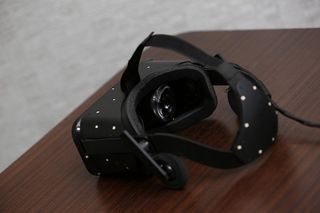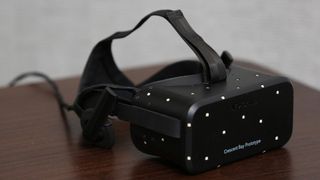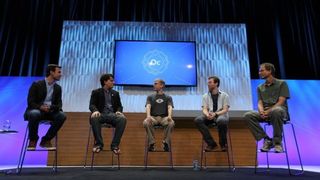Oculus Rift Crescent Bay prototype hands-on

Wow. I thought I had experienced virtual reality before I put on Oculus VR's new prototype Crescent Bay headset . I put on the original Rift when it was still a duct-taped prototype. I've played game demos on the higher resolution Crystal Cove prototype, which added positional tracking, and the polished version that is now shipping as DK2. Every one was amazing: an experience with a technology that was clearly on the cusp of changing gaming as we know it. Putting on Oculus VR's Crescent Bay is a different experience altogether. Those previous headsets were just shadows of virtual reality, simulacra that asked you to fool your brain into believing in the magic. In some of the Crystal Cove demos, I found myself having to remind my brain that this wasn't real, because all my senses were telling me otherwise.
In their keynotes at Oculus Connect, the brains behind Oculus kept talking about “presence”—what it takes to create total immersion in virtual reality. It sounded like a buzzword to me, until I strapped Crescent Bay onto my face, placed its integrated earpieces over my ears, and stood on the ledge of a skyscraper looking out over a virtual steampunk cityscape. I looked down, tried to step off the ledge, and my body recoiled. I was there.
Presence
As soon as I put on Crescent Bay to experience a series of about 10 one-minute demos, I bought into Oculus' talk about presence. It's a difficult sensation to describe, but if you've used an earlier version of the Rift you may be able to imagine it.
When you wear DK2, it's rare for you to feel like you're really there. Mostly, it feels like playing a video game in a really, really cool way, but you remember you're sitting in a chair, holding a controller, and you can see the edges of the screen projected in front of you. The “screen door effect” in DK2 is much improved over DK1, but it's still there, since only 960x1080 pixels are projected in front of each eye. Your head movements are tracked, but you can't turn all the way around or stray too far from looking straight ahead. At the best moments, like when you're jamming on the thrusters in Elite Dangerous and locked onto an enemy fighter's tail, you may experience that rare slip into feeling complete immersion.
Crescent Bay is like that immediately, but better. You're there.
Oculus' demonstration ran through a number of software demos designed in-house, with a sci-fi military demo from Epic Games closing things out. Most of them were built in Unreal Engine 4. In one, I stood in the pulsating engine room of a submarine and looked around at dials and pipes and listened to the hum of the engine. In another, a gigantic T-Rex lumbered down a hallway towards me, roared in my face, and stepped over and past me. I turned around to watch it go.
The biggest experiential difference with this demo was standing; I stood in the middle of a room and could actually look and walk in three dimensional space, and as I did so I walked around in the environment. Taking a single step forward or to the side immediately kicked in the “presence” Oculus talked about. My brain just utterly, completely bought it. I had a big, stupid grin on my face during the first three or four demos, and I couldn't make myself stop grinning for the first few minutes. I actively tried, but it was like an uncontrollable response—my face's way of saying “this is unbelievable.”
The biggest gaming news, reviews and hardware deals
Keep up to date with the most important stories and the best deals, as picked by the PC Gamer team.

I turned around 180 degrees to see what was behind me. I crouched down and loomed in close to a tiny model city with cartoony trains running through it and a UFO hovering above it. The new audio plays a big role in selling the sense of presence—Oculus designed these demos to take advantage of positional audio, and proximity and directionality of sound is a key ingredient in Crescent Bay's immersion. The integrated earpieces sounded fine, but are nothing special, technically—it was the way they were used that made a huge difference.
I completely understood what Oculus meant by presence when I stood on that ledge and felt instinctively scared of looking over the edge. I felt it in another demo, which felt like the video game Rez, or a simulation of traveling through a computer network in cyberspace. Neon blue lights lanced through concentric geometric shapes which rotated and slid through space as I coasted forward. I'd step sideways to get out of their way, and when a block too large to dodge came towards me, it was physically uncomfortable to watch—feel—it pass through me.
When something like that happens, it breaks that feeling of presence. When I stood on that skyscraper ledge, I tried to step off, and hesitated. But then I made myself step forward, and I was standing on nothingness. When I was looking down and could see that, it broke presence. Similarly, holding my hand up in the air and not seeing a modeled version of my hand, or looking down and not seeing legs, broke the illusion.
The demos Oculus used to show off Crescent Bay were all simple, and wisely used their simplicity to very quickly convey that sense of presence. None of them were controllable, and they mostly encouraged standing still and gaping, or taking a couple steps in any direction. A rubber mat in the center of the cubicle helped assure me that I wasn't about to smack into a wall.

Limiting what was possible in the Crescent Bay demos made them more effective. The best parallel I can draw is to the Omni treadmill, which I tried out while wearing an older Oculus Rift headset. In the Omni, your steps translate into game movements, but this requires some special shoes and awkwardly sliding your feet along this concave plastic surface. It can be immersive, but it doesn't feel real . It's a tricky distinction, but when you're able to walk and look around and feel the ground under your feet, it truly feels real. There were moments where Crescent Bay really and truly tricked my brain.
Oculus says that Crescent Bay is as big a jump from DK2 as DK2 was from DK1. I say it's bigger. This is some next level shit. Hyperbolic enthusiasm is the only way I can convey the sense of wonder and excitement I felt for the 10 minutes or so I was wearing it.
Hardware and limitations
I've gushed long enough, and now it's time to manage expectations. Crescent Bay hasn't just magically solved all of VR's tricky problems. I still felt the telltale hints of motion sickness after a few minutes, and I'm not sure exactly what caused it. I'm sensitive to motion sickness, in general, and easily get nauseous on planes or when I read in a car. I felt fine after the demo, but I probably would've felt a little bit queasy if I used it for another 10 minutes. Maybe that's from latency, or from the refresh rate, which is higher than DK2 at 90Hz. Still, I think vertigo issues are reduced from DK2, and Crescent Bay may not bother the strong-stomached at all.
I suspect that the sense of presence I felt would have dissipated more quickly or more easily if I had a controller in my hand or if I was playing a more traditional game. Oculus wasn't showing off anything like that. This is already a see-it-to-believe-it experience, and I think that goes double for games with actual complexity to them.
Thinking about more traditional games in this form worries me. Oculus wasn't talking about them much. They talk much more about “experiences.” I like experiences just fine. But I also like video games, and I'm not sure how those will work while standing and walking around with a cord tethering me to my PC.
When I talked to Oculus' Nate Mitchell and Palmer Luckey, both hammered home the statement that Oculus is a seated experience...while simultaneously grinning in a way that seemed to say but we're totally developing this incredible technology dedicated to letting you stand and walk around, so do the math . The new camera for tracking positional data has a very wide field of view, according to Luckey. White locator dots on the back of the headset allow for a full 360 degrees of movement. The ability to walk is so immediately compelling, I don't want to have to go back to using a joystick to move a character. Doing that is going to take some of the magic out of the experience of Crescent Bay, but the technology is, at least, still a major advancement from DK2.

Oculus isn't talking specifics about the hardware in the new prototype, but here's what I can say for sure: the screen is higher resolution, the optics you snuggle up against your eyes are clearer and more comfortable, and the entire headset is noticeably, significantly lighter. The screen door effect is almost entirely gone. The display still isn't near the pixel density that Oculus eventually wants it to be—Michael Abrash says you'd need about 8Kx8K per eye to achieve the density of your average desktop monitor, given how close the Rift screen sits to your eye—but this screen is absolutely good enough to ship in a consumer version. According to Mitchell, the quality of the visual experience isn't just about the raw resolution of the display—it's also due to how they design the optics to show you that screen.
Mitchell confirmed the demos were running at 90Hz on high-end systems using the new Nvidia Maxwell graphics cards. That's another worry about the hardware's eventually usability. Oculus keeps making it better, but properly running a game in stereoscope, at a high resolution, at 90Hz, is going to demand a hell of a PC.
Oculus doesn't have plans to demo Crescent Bay again anytime soon, so I feel cruel saying that you should experience it as soon as you can. I know that's going to be a wait. Mitchell told me Oculus has no plans to sell Crescent Bay, which doesn't really mean much. It could be a DK3 release next year, or eventually morph into a more polished consumer version. When you do use it, in some form, it's going to be something special. This is the one we've been waiting for.
There are still huge challenges ahead—developers have to make games that work well in VR, PCs are going to have to be very powerful to run VR games, and motion sickness still isn't a completely solved problem. I think Oculus and game developers can figure all those out.
When I was standing up on that ledge, I took in the zeppelin in the sky, the steampunk architecture, and the imposing skyscraper that dominated the nighttime skyline. The top of the tower was fitted with Oculus VR's logo, with Oculus HQ emblazoned underneath. That seems about right. If the consumer Rift lives up to Crescent Bay, this thing is going to rule the world.

Wes has been covering games and hardware for more than 10 years, first at tech sites like The Wirecutter and Tested before joining the PC Gamer team in 2014. Wes plays a little bit of everything, but he'll always jump at the chance to cover emulation and Japanese games.
When he's not obsessively optimizing and re-optimizing a tangle of conveyor belts in Satisfactory (it's really becoming a problem), he's probably playing a 20-year-old Final Fantasy or some opaque ASCII roguelike. With a focus on writing and editing features, he seeks out personal stories and in-depth histories from the corners of PC gaming and its niche communities. 50% pizza by volume (deep dish, to be specific).
Most Popular





